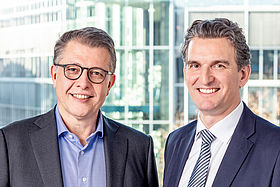Loading content …
19 March 2021
No return of the spectre of inflation
While the COVID-19 year has come and gone, its massive government aid programs have stirred fears of the long-forgotten spectre of inflation. But are the fears actually justified? We don’t think so. Neither will an accommodative monetary policy necessarily trigger a rapid rise in inflation, nor is a consumer spending rally to be expected.
The media and the financial markets have lately seemed preoccupied with a single issue: inflation. And once again, all eyes are on the development in the United States. But the inflation rate here equalled a mere 1.4 percent in January, slightly lower than expected. It did nothing, however, to check the rise in inflation fears. The fact is most notably reflected in rising interest rates: The yield for US bonds with a ten-year maturity rose from 0.9 to 1.5 percent since the start of the year. However, this merely returned it to the level of January 2020. For the sake of comparison: In December 2019, the interest rate stood at 1.9 percent, and was actually 2.6 percent in January 2019.
As far as we can see, there is nothing remarkable about the trend. Nor has the Federal Reserve Bank deemed it reason enough to revise its monetary policy. However, there are some economists who see a high danger of inflation in the combination of an extremely accommodative monetary policy and fiscal policy, the latter motivated by the COVID-19 pandemic. This warrants the comment that there is basically always someone warning of the inflation risk no matter what the circumstances. The press on either side of the Atlantic will eagerly lap up sensational news of this sort, though by no means all publications. Reassuring to note, several articles in leading German dailies and business papers carried well-informed analyses of the situation. We, for one, agree with those articles that see no harbingers of a looming crisis.
For starters, we would like to point out that developments in the United States have no direct repercussions for the monetary policy in the European currency area. The European Central Bank (ECB) did not raise its interest rate in order to adjust it to the US interest rates. It bases its monetary policy targets almost exclusively on the inflation or the inflation risk within the European currency area. The inflation rate in that area has admittedly perked up slightly, rising from 1.0 percent in January to 1.3 percent in February. Again, though, the figures in 2020 were quite similar. Prominent industry insiders, such as the president of the Bundesbank, do expect to see rates rise by around 3 percent over prior year. But we need to remember that the pandemic caused inflation to dip temporarily into the negative range in 2020.
To be sure, there is reason to expect people to catch up on their consumer spending once the pandemic comes to an end. At the same time, though, a large number of people will try even harder to set money aside: those who lost their job during the crisis or those who fear they might find themselves out of work in the near future. Similarly, all the self-employed professionals who sustained heavy losses or had to file for insolvency will not boost consumer spending. There will be no price hike without a surge in demand, and no rise in inflation. In a parallel development, the increase in sales tax and the introduction of the CO2 tax will cause a one-off upward push. None of this points to a sustained consumption surge, though. Analogously, the inflation rate would not keep going up indefinitely, either.
Interest Rate Development
For the first time in months, there has been a noticeable shift in long-term interest rates. For instance, the 10-year interest rate swap rose from -0.18 percent at the start of the month to 0.04 percent at the end of the month, moving back into the positive range for the first time since May 2020. The short-term interest rates, by contrast, remained largely stable. The 3-month Euribor rose from -0.543 percent at the start of the month to -0.530 percent by the end of February. Analogously, the 6-month Euribor perked up slightly from -0.528 to -0.516 percent.

Outlook
In Germany, too, some economists have warned of a looming threat of high inflation rates. At best, it is therefore safe to say that the future development is subject to controversy. Venturing long-term predictions for the trends in inflation and interest rates is anything but easy even during normal times. The second major economic crisis within the first two decades of this century is not making things any easier. But there is nothing about the current economic scenario that suggests convincingly that the, by all means copious, fiscal- and monetary-policy aid programs will necessarily result in a permanent and substantial surge in consumer spending and therefore in runaway inflation. Given the then-as-now very low interest level in Europe, we are not aware of any sign that the inflation expectations among the actual market players have seriously shifted. Anyone active in the real estate market is well advised to keep a close eye on developments going forward. But we see currently no reason for a fundamental re-assessment of our view of the market.
Disclaimer:
The article reflect the opinion of the authors. Nevertheless, the provider and authors assume no liability for the accuracy, completeness and timeliness of the information provided. In particular, the information is of a general nature and does not constitute legally binding advice.
Publisher

Francesco Fedele Prof. Dr. Steffen Sebastian
Prof. Dr. Steffen Sebastian
Holder of the Chair of Real Estate Finance
at IREBS, University Regensburg
Francesco Fedele
CEO, BF.direkt AG

